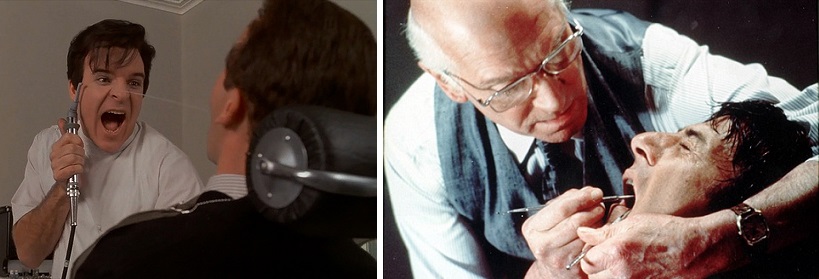
Last year, around this time, it was me in the dentist chair. I blogged about it… about my fears, about what happened and what I needed to have done after not visiting the dentist in about 2 years. Well, this year, here we are, on the brink of Dental Month in the veterinary world, and it’s our longtime hospital administrator, Josh, who finds himself at the dentist. Josh doesn’t really love the dentist. Let me say that differently: he doesn’t even like the dentist. He tries to avoid going, he doesn’t want to pay for anything that isn’t “absolutely necessary” or “causing pain”. I’m sure all of you who know how stories like this go are clued into what’s coming next. You’re right: this doesn’t always turn out in Josh’s favor. Those times dismissing the need for a dentist visit (even just for a check-up) can so easily lead to those things that most of us agree to fear: root canals, fillings and crowns, etc.
More often than not, in the veterinary field, we deal a lot with the idea of “how does this compare to human health”? In this specific case, it has its similarities. When dental work is put off, it can lead to much bigger issues. That goes for humans and pets alike. Here is where it goes on a slightly different path, however. Those of us who have experienced very painful toothaches can attest to how debilitating that can be until it gets taken care of. As humans, we can (and so often do) tell anyone and everyone about that pain…sometimes to the point where the other person has heard enough about it and forces us to go to the dentist. However, our pets don’t have that luxury. And, as surprising as it may be, they won’t yelp or cry out with every painful bite they take while experiencing some level of mouth pain.
 Mouth or tooth pain are not the only health issues that can occur with poor dental upkeep for your pets. Owners are surprised to hear that many respiratory, kidney, liver and heart problems can be caused by bacteria spreading from the mouth. That’s right; a prolonged lack of attention to your pet’s mouth could lead to some extremely serious problems. I always remember one of the ways that Dr. Wheaton described it to me a while back after dealing with a dog that needed significant dental work done: if these issues were outside of the mouth and visible, they would be sizable wounds that the owners would react to and act upon immediately. The problem is, these are “internal” issues that most owners never see and are not being alerted to.
Mouth or tooth pain are not the only health issues that can occur with poor dental upkeep for your pets. Owners are surprised to hear that many respiratory, kidney, liver and heart problems can be caused by bacteria spreading from the mouth. That’s right; a prolonged lack of attention to your pet’s mouth could lead to some extremely serious problems. I always remember one of the ways that Dr. Wheaton described it to me a while back after dealing with a dog that needed significant dental work done: if these issues were outside of the mouth and visible, they would be sizable wounds that the owners would react to and act upon immediately. The problem is, these are “internal” issues that most owners never see and are not being alerted to.
My pets can have plaque and tartar, too?
Plaque and Tartar. We all know what these are, right? In the human world, some people let this ride out to the extreme before acting upon it. The problem with tartar on your pet’s teeth can be what can’t be seen underneath it. In a great many cases, what lies hidden behind that hard shell (that can even appear to be your pet’s tooth by just looking at it) can be anywhere on the scale from “pretty bad” to “that tooth needs to be extracted”. Think about a pier with the inevitable attachment of sea creatures in a small amount of time. It’s a natural phenomenon for bacteria in the mouth to adhere to a tooth and as time goes by, the minerals in the mouth will allow for that bacteria to form into a cement-like matrix called calculus or tartar. All of us also have a defense mechanism in our mouth to protect our bodies against things from the outside coming in through the mouth and creating disease. When bacteria persists in the form of calculus, the inflammatory process is constant.
Persistent calculus provides unending immune system stimulation, causing gingivitis which then eventually results in gum recession. When enough gum recedes, there is no barrier to protect the underlying bone which holds the teeth firmly in place; eventually that bone is eroded as well. Bone loss creates a loose tooth and at that point, the battle is over. Well, kinda. At this stage, at the minimum, the tooth is doomed for a healthy survival but it’s not that easy for an immune system to kick out a barnacle covered pier pylon. It can take years for enough bone to be lost to enable a tooth with a long or complicated root structure to fall out on its own, so during that time the inflammatory response continues unabated in the mouth until this gaping wound with a hunk of tooth in it is removed one way or the other. If you have ever experienced what an “exposed root” feels like, you know well how tremendously painful that can be. When these issues are identified, the affected tooth needs to be extracted.
 Some dogs and cats can have their teeth cleaned without any anesthesia. We work with a local company to have extensively trained technicians do preventative cleanings for your pet at our hospital. They do awake cleanings on cats and dogs ranging from Chihuahuas all the way to Great Danes. Not all pets are able to receive a non-anesthetic dental cleaning: whether they just don’t like someone holding them to clean their teeth, or their dental health demands more work than can be taken care of by a dental cleaning without anesthesia. In such cases, a staff member will go over the best possible treatment plan for the well-being of your pet with you before any course of action is taken.
Some dogs and cats can have their teeth cleaned without any anesthesia. We work with a local company to have extensively trained technicians do preventative cleanings for your pet at our hospital. They do awake cleanings on cats and dogs ranging from Chihuahuas all the way to Great Danes. Not all pets are able to receive a non-anesthetic dental cleaning: whether they just don’t like someone holding them to clean their teeth, or their dental health demands more work than can be taken care of by a dental cleaning without anesthesia. In such cases, a staff member will go over the best possible treatment plan for the well-being of your pet with you before any course of action is taken.
Out of sight and out of mind is too often what occurs in regards to a pet’s dental well-being. Our staff always has our patients’ best interest at the forefront of every decision and conversation with our clients. Thus, we are vigilant with our efforts of keeping you aware of all the latest developments within the veterinary dental field. We do our best to encourage you to be the best possible advocate for your pet and their overall health… and that doesn’t just begin or end with their mouth.
Your pet needs a dental cleaning — what is involved with that?
Non-Anesthetic Dental: Dental cleaning without anesthesia is an option for good-natured pets without serious dental disease such as periodontitis or damaged teeth. Available for both dogs and cats, these dentals are a great way to keep your pet’s teeth clean and healthy. Our trained technician cleans under the gumline, probes the mouth for pockets and polishes all teeth surfaces.
Anesthetic Dental: Pre-dental blood work is required. This is a check on the overall health of the pet to make sure that liver, kidneys, and blood counts are within normal ranges to reduce any risks possible prior to the anesthesia.
With either procedure there are steps in the cleaning process:
– Scaling: removes tartar above and below the gum line.
– Flushing or Rinsing: removes dislodged tartar from teeth and helps to remove the bacteria that accompany tartar.
– Polishing: smoothes the surface of the teeth making them resistant to additional plaque formation.
– Fluoride: coating decreases teeth sensitivity strengthens enamel and decreases the rate of future plaque formation (done with anesthetic dentals).
Here’s some very good news: February is Dental Month! We have some great discounts to lessen the financial burden of keeping your pet’s mouth and teeth in healthy condition. We are offering 10% off any Non-Anesthetic Dental Cleanings, 15% off any Anesthetic Dental Cleanings and 5% off any necessary Dental Extractions.
If you are noticing any of these issues with your pet or it is time for their maintenance cleaning, or to take advantage of Dental Month discounts, please call our staff at (949) 768-1313 and set an appointment.
About The Author
Tim Wheaton, Office & Media Manager | A part of the APCC team since September of 2013 as the Office Manager and Media Manager. His career previously had been steeped in the Title Insurance Industry for over a decade. He has managed staffs in multiple industries, locally and overseas. His marketing and Social Media skills were learned as he manages his own photography business & podcast called “Daddy Unscripted” about being a dad.
Read More About Tim
There is no coincidence in the shared last name. Tim is Dr. Wheaton’s younger brother and has been around APCC and the staff since its inception. Life has come full-circle in that way, as Tim and his brother used to spend nearly every day during summers in their youth at their Dad’s veterinary practice in Corona Del Mar. Dr. Wheaton was always the son destined to follow in their father’s footsteps, while Tim was always the more creative-minded one of the two.
Tim and his wife have two kids of their own and two furry children (Rusty & Audrey), sibling cats adopted from The Pet Rescue Center in 2011.
Tim will be keeping you up to date with APCC happenings via social media – Facebook, Twitter, Pinterest, Instagram – with pictures, pet health tips, travel tips and ways to keep your babies happy and healthy.

